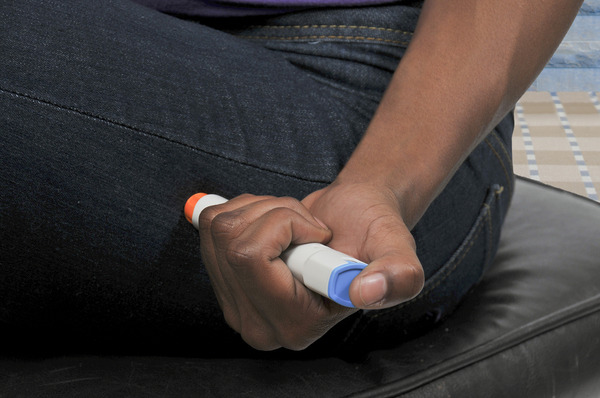Having the device on site can save a life

There was a time when automated external defibrillators (AEDs) were considered liability risks for the workplace and employers avoided them like the plague. Today, they have become commonplace both in public spaces and in company health and safety programs. In fact, they are becoming increasing popular items that people buy for homes and cottages. We have come a long way in our journey to setting the stage for improvement in survival rates from cardiac events.
Another medical device that saves lives but is not yet considered common safety equipment for the work environment is the EpiPen auto-injector. EpiPens are available by prescription in Canada, making it difficult to obtain them as “stock” for the first-aid supply room. When a person has an allergy that could result in the most severe reaction called anaphylaxis, a doctor prescribes the EpiPen for their use. Most people who are at risk for anaphylaxis carry an EpiPen wherever they go.
As a result, you probably think that stocking them in your company health and safety room is unnecessary. However, there are a few scenarios that could arise where having an EpiPen on site could save a life.
•It could be the first time your employee has an anaphylactic reaction. Some allergies can start out with very mild reactions but can unexpectedly escalate in severity. Unfortunately, you can’t always predict when you’re going to have your first life-threatening reaction to an allergen.
•If an employee has never had exposure to a particular allergen, they may not even know they are allergic to it until an anaphylactic reaction occurs.
•An employee may carry one EpiPen with them at all times, but in some reactions, a second dose is necessary before EMS arrives.
•EpiPens can be forgotten, especially by a person who could be at risk for anaphylaxis, but who has not yet experienced the severity of it. They may be complacent about always bringing their EpiPen with them, leaving them at risk for a severe reaction and no EpiPen available to save them.
•If members of the public frequent your workplace location, such as a restaurant, the risk of an anaphylactic reaction is higher.
To improve their ability to respond to anaphylaxis emergencies, employers should know which employees have the potential for anaphylactic reactions and advise all staff not to bring anything to work that contain the allergens that could potentially cause a life threatening reaction. They should also establish a response protocol should an anaphylactic reaction occur and ask the employees who have EpiPens if they would like to keep an extra auto-injector at work.
It’s important to provide a place for the EpiPen that is accessible to the employees who will be trained to use it. Do not put the EpiPen in the first-aid kit as the kit contents are regulated by First Aid Regulation 1101 and this regulation does not include auto injectors at this time.
As with any new piece of equipment, the employer who has it on site has an obligation to train employees to use it. Conveniently, Epipen Canada provides free training kits and interactive training videos at www.epipen.ca.
One concern that would need to be addressed during the training on the use of auto-injectors is the possibility of user error. If you put your thumb on the wrong end, you could end up injecting yourself with the epinephrine. For most people, this just causes a huge adrenaline rush and perhaps some temporary circulation changes in the digit that was stabbed by the needle. The other issue that will arise is that the epinephrine that was destined for the person in distress, is no longer available unless another EpiPen is on site.
Lastly, if you are going to keep it in stock, make sure it is up-to-date. You can check the date on the device or sign up for a free email reminder at www.epipen.ca.






